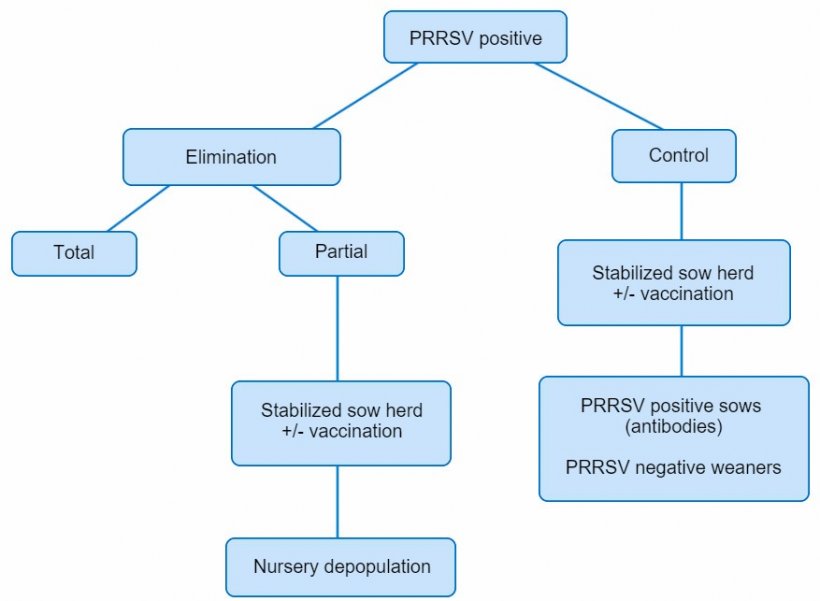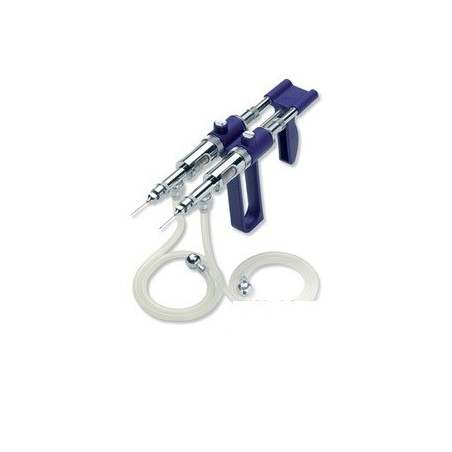Introduction
Porcine reproductive and respiratory syndrome (PRRS) is widespread in Danish sow herds and several different measures are used to eliminate the PRRS-virus (PRRSV) (Figure 1). One of the methods is to use blanket vaccination with MLV followed by partial depopulation. All the sows, gilts, boars and sometimes offspring are vaccinated at least twice (blanket vaccination). The purpose is to stabilize the sows and to wean PRRSV negative piglets. Nursery pigs and/or finishers units with PRRSV positive pigs are then emptied, cleaned and disinfected prior to movement of the first batch of negative piglets.


Aims of the study
To investigate the dynamics, persistence and genetic characteristics of PRRSV in three Danish sow herds that remain PRRSV positive despite different attempts to stabilize the herds. In addition, we wanted to compare different sample materials for the detection of PRRSV in different age groups.
Methods
Herds
Herd 1 is a SPF production herd with 1,500 sows and production of 30 kg pigs. PRRSV stabilization was attempted in January 2013. All sows and all pigs in the nursery were vaccinated with MLV against PRRSV-2. The nursery was depopulated, washed and disinfected, and then left empty for 4 weeks. Since then, the sows were vaccinated twice a year with the latest vaccination in May 2016 (piglets/weaners not vaccinated at that time). The herd rears its own gilts off-site.
Herd 2 is a SPF herd with 700 sows and produces mainly 30 kg pigs. The owner bought the herd in 2012 and vaccinated all newly acquired the animals (gilts and sows). The problems with PRRSV started in 2014, mainly in the weaners with an increase in piglet mortality up to 22%. In April 2016, all sows were vaccinated and revaccinated 4 weeks later with MLV against PRRSV-2. In addition, piglets (at days 10-12) were MLV vaccinated, but piglet vaccination stopped in June 2016. Strengthened management strategies (McRebel) were applied at the same time as the vaccination started. All gilts were purchased from a PRRSV negative herd at an age of 12-23 weeks, vaccinated, and quarantined for 8 weeks.
Herd 3 is a conventional production herd with 1,100 sows selling pigs at 30 kg. PRRSV problems started in 2002-2003. The observed clinical signs were mainly abortions in the sow unit. The herd started to eliminate PRRSV years ago, where all weaners were MLV vaccinated (against PRRSV-2) for a period of 4-5 months. In April 2015, all the sows were vaccinated and revaccinated 4 weeks later. All gilts were purchased from PRRSV positive herds (PRRSV-1 and PRRSV-2) at an age of 21-24 weeks. Gilts were MLV vaccinated against both PRRSV-1 and PRRSV-2 type 1 and type 2, when they were 10-12 weeks old. Upon arrival, gilts were not quarantined.
Study design
This cross-sectional study was performed in September/October 2016 where the herds were tested for PRRSV status in different age groups (pigs at age 0, 4, 8 and 12 weeks). The study consisted of two parts: A management related observational part (questionnaire, clinical registrations), and a virus detection and genetic characterization part with collection of blood serum samples, tonsil swabs and placenta-umbilical cord serum (PUCS) samples. Samples were tested for PRRSV by quantitative RT-PCR in pools, and some were further chosen for sequencing to explore genetic variations (Sanger and Next-Generation Sequencing).
Results

In all herds, the management did not follow all the recommended procedures, e.g. herd 1 did not follow AI/AO principles in the farrowing unit and there was no strict routine regarding movement between the sections. Herds 2 and 3 did not follow AI/AO it in the nursery unit and in herd 3 none of the staff members washed hands and/or boots or changed boots between each unit.
All PUCS samples were PRRSV negative by qRT-PCR. Serum samples were positive in herd 1 (12 weeks), herd 2 (8 and 12 weeks), and herd 3 (4, 8 and 12 weeks) (table 1). There was full agreement between results of test of pooled blood serum and tonsil swab samples from pigs at 12 weeks of age, however, Ct-values from serum samples were significantly lower (p = 0.003) than from tonsil swabs. Sanger sequencing (ORF5) revealed 98.8-99.5 % identity to the PRRSV-2vaccine strain. No viral variants (quasispecies) were found using NGS (data not shown).
Table 1. Results of qRT-PCR analysis of the PUCS, serum, and tonsil swab samples
| 0 weeks old | 4 weeks old | 8 weeks old | 12 weeks old | |
| Herd 1 | ||||
| PUCS | 0/14 | - | - | - |
| SERUM | - | 0/6 | 0/6 | 5/6 |
| TONSIL | 0/12 | - | - | 5/6 |
| Herd 2 | ||||
| PUCS | 0/12 | - | - | - |
| SERUM | - | 0/6 | 4/5 | 6/6 |
| TONSIL | 0/12 | - | - | 6/6 |
| Herd 3 | ||||
| PUCS | 0/16 | - | - | - |
| SERUM | - | 3/6 | 2/6 | 6/6 |
| TONSIL | 0/12 | - | - | 6/6 |
Discussion/conclusions
None of the three herds followed McRebel strictly and all were PRRSV-2 positive. Yet, occurrence of clinical signs among pigs were low, showing that clinical signs were not a good indicator for the PRRSV status of these herds. None of the piglets tested during the first week were PPRSV positive indicating that the three sow herds were indeed stable. Blood samples seemed more sensitive than tonsil swabs for the detection of PRRSV. The sequences from the circulating virus in the three herds had very high similarity to the vaccine strain indicating that the vaccine strain circulated in the herds.
Although the use of vaccination was effective in stabilizing the sows, the results of these case studies emphasized that elimination of PRRSV from the nursery can only be accomplished if vaccination and partial depopulation/disinfection are supported by strict implementation of all recommended management procedures, including AI/AO.







